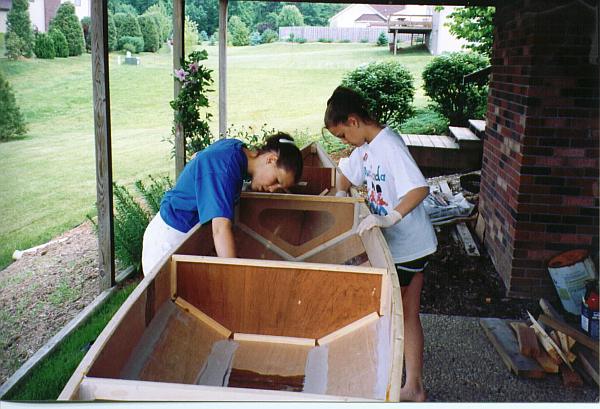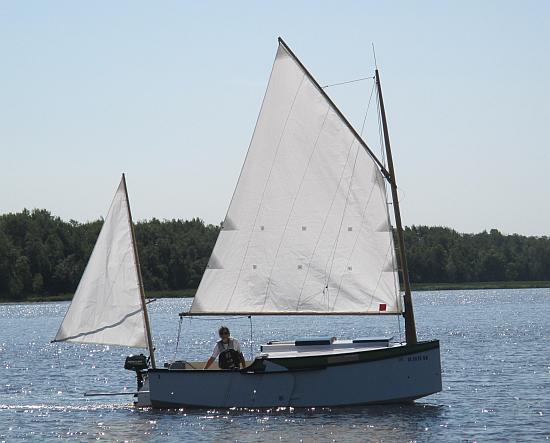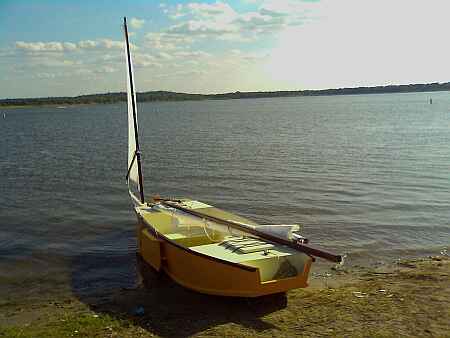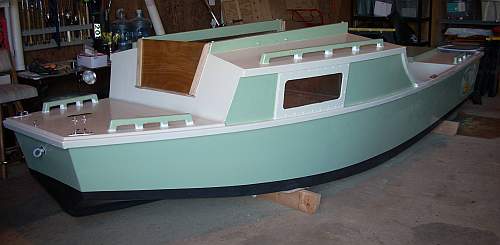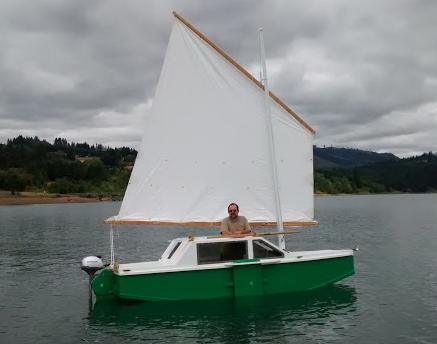Jim Michalak's Boat Designs
1024 Merrill St, Lebanon, IL 62254
A page of boat designs and essays.
(15 March 2018) We discuss sailing trim. The 1 April issue will build some Totos in days gone by.
THE BOOK IS OUT!
BOATBUILDING FOR BEGINNERS (AND BEYOND)
is out now, written by me and edited by Garth Battista of Breakaway Books. You might find it at your bookstore. If not check it out at the....REND LAKE 2018...
...will take place on June 8 and 9, always on the weekend before Father's Day weekend. WE HAVE ALREADY NAILED SITES 25 THROUGH 29 SO THE END OF THE LOOP IS OURS. THANKS TO ALL WHO HELPED NAIL THEM DOWN.
ON LINE CATALOG OF MY PLANS...
...which can now be found at Duckworks Magazine. You order with a shopping cart set up and pay with credit cards or by Paypal. Then Duckworks sends me an email about the order and then I send the plans right from me to you.
Sail Rig Trim 2
Last issue we looked at the basic balance of a sailing rig and looked at things that can change it. It is quite a compromise, isn't it? If you set your rig up to sail with just the right helm on one point of sail, everything conspires to change the helm on the other points. In this issue we'll look at trimming your sail rig to get the best compromise.
THE IDEAL...
What I usually look for first is a good handful of weather helm in a good sailing breeze, enough wind to heel the boat maybe 15 degrees when on a close reach. A "good handful" would not be enough to tire you over the space of a few hours, but if you released the tiller the tiller would swing to the lee side of the boat quickly and the boat round up into the wind within a few seconds. When tacking through a good wave, the boat would swing quickly with maybe 30 degrees rudder deflection, that done in one quick and smooth motion. A sharpie, even a larger one like Birdwatcher, can run out of momentum quickly when tacking so the tack must be quick, perhaps less than five seconds to swing through 100 degrees although the larger the boat the more time it will take (and the larger boat will have more momentum to get though).
Having that I would hope for at least a neutral helm when sailing to windward in light winds. I think about every boat I've had, including all the Bolger boats, had slight lee helm in very light winds and I lived with it. Tacking in lighter winds might be a lot slower. If there is a lot of motorboat wake around you often won't be able to complete a tack in very light winds and will have to paddle your way to the new direction, then get the sails drawing again on the new tack.
Then I would look for enough rudder control on downwind.
WHAT TO DO ABOUT IT...
If your boat has too much weather helm you would think that the sail forces are too far aft of the hull forces. If you have a pivoting leeboard or centerboard, you can sweep the board aft on its pivot. That should move the board area aft and bring it into alignment with the sail force. There is a powerful arguement that boats should be designed this way from the start - with the sail area too far aft with the idea that the pivoting board will be swung up to adjust. Trouble is that we have in our minds an idea of what a boat is supposed to look like - the sails way up front. On a leeboard boat that is hard to get along with since the leeboard will have to go up front too and with it the widest beam of the hull. It would work pretty well with a scow hull but with a pointy bow we all seem to want our sails up front and our big beam behind!
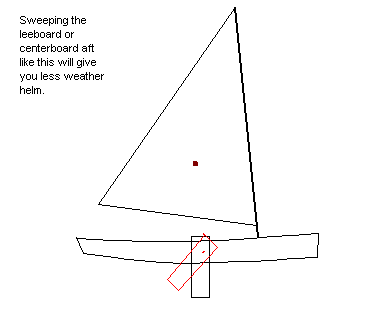
ADJUST SAIL POSITION...
This rig trim game is usually one of inches. I think about the most effective way to trim out a rig is by adjusting the rake of the mast. If you look in Howard Chapelle's great books about boating 50 or 60 years ago, you will see that the old timers sometimes used adjustable mast steps. They could move them fore and aft just a few inches. But a few inches of motion on the step moves the sail above by a lot, usually maybe four times the step adjustment. For example, if I were to move the mast step on Birdwatcher forward two inches, the mast is raked aft and with it goes the sail. The tip of the mast would move aft about ten inches. The triangular sail of Birdwatcher is tied right to the mast. Its center of area would move aft about 4".
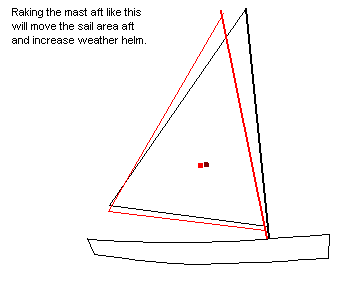
For a lugsail the effect is even more pronounced because the sail is tied right to the top of the mast. So, let's say with IMB that we have a 16' mast with 2' between step and partner, then moving the step forward .5" moves the tip of the mast aft 3.5". With it would go the entire sail area since the entire sail hangs from the masthead.
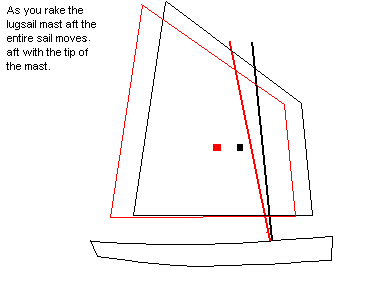
Of course, you would get the same effect by moving the mast partner aft instead of moving the step forward.
Rob Rhode Szudy had the best arrangement for this type of adjustment that I have seen. It was on his Piccup Pram. The mast heel on Piccup Pram is 2-1/4" in diameter. He whittled one side of his mast heel down like this:
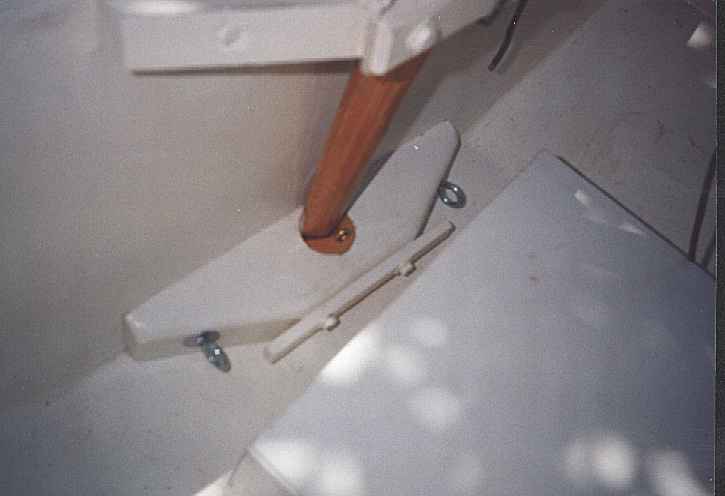
So it would move foreward and aft in the step. Then he whittled out a shim to fit. If the shim is installed towards the front of the step the mast is raked forward. If the shim is shifted to the back part of the step as in the photo then the mast rakes aft. I think the old timers sometimes did something similar by fitting wedges at the mast partner.
My own Piccup has something similar by accident. When I enlarged the sail area by increasing he hoist by 2' I had to lengthen the mast. How to do that? I cast about the shed and found an old oar. I cut the blade off and found the loom was the same diameter as the Piccup mast tip. So I scarfed the oar loom to the original mast tip to lengthen the mast 2'. But he loom was not straight! The oar was a "found" oar, probably pitched because it was so crooked as to be useless. So my mast was not straight. It is curved a few inches! Usually I mount the curved mast with the sweep aft. That sets the sail aft a bit and I get a bit more weather helm. So if you make a mast that is not straight, don't dispair. What you have there is a special "adjustable helm" mast.
IF YOU HAVE A LUG RIG...
...you have another option of moving the hoist point fore and aft on the yard. Having used these for almost 20 years now I can tell you that they function best with the yard crossing the mast at about 40% like this:
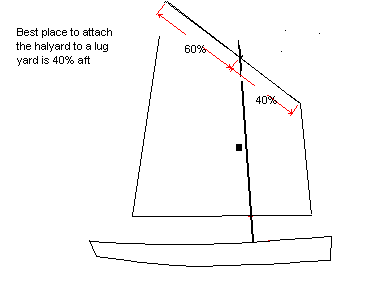
So what is "about 40%". That is within a couple inches on a normal sized boat - not much variation allowed. If you move it forward on the yard you will get more twist to the sail which can hurt you a lot when close hauled. If you move it aft on the yard the sail may be overbalanced and not flop over to the new tack at the right time. Also remember that there must be some looseness up there to allow the yard to swing freely but not so much that the yard pumps back and forth in rough water. Usually everything conspires to pull the sail aft of the desired hoist point, so if you tie it at 40% the sail might set at something like 35% which is probably OK.
Here is a little trick I like to use on my own lug sails. Have two hoist points on the hard, one at 40% and another at maybe 35%. In strong winds you hoist at the 40% point and in light winds you hoist at the 35% point.
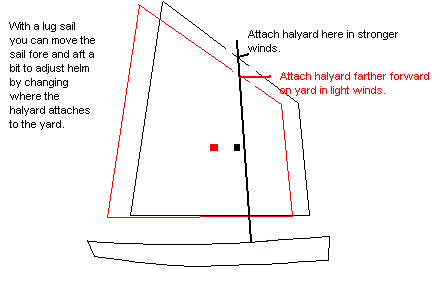
So in strong winds you would expect the most weather helm and the most sail twist due to the increase force on the sail. So you hoist the yard aft which sets the sail forward which reduces weather helm and sail twist.
In lighter winds you would expect the least weather helm, maybe even neutral or lee helm. So you hoist the sail with the halyard forward a bit on the yard, which sets the sail aft and that increases weather helm. Excessive sail twist is usually not a factor in light winds so you can get away with it.
Experiment a bit here.
Harmonica
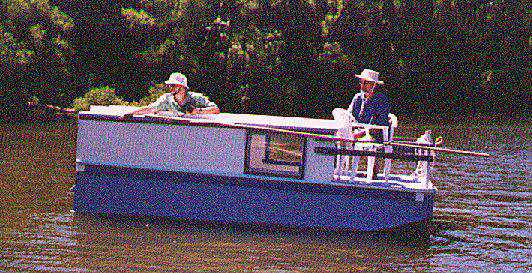
HARMONICA, MINISHANTY, 13' X 5', 400 POUNDS EMPTY
Harmonica is a tiny shanty boat that sleeps two in its cabin. There is a porch up front suitable for lounging and a small room in the stern for the kitchen and the water closet. I think it is arranged so that two people could wait out an all day soaker without feeling too pressed. For protected waters only. I've been asked more that once if Harmonica would be OK in the Ohio River, etc.. My answer is no. In calm weather you might get away with it but you always run the risk of huge wakes, especially from large motor yachts. The prototype Harmonica was built by Chris Crandall of Lawrence, Kansas.
This boat was originally called Fusebox. It was intended to be an electric boat for the wonderful little conservation lakes we have around here. But later I thought that the electric scheme was strained because few trolling motors could push this box on a windy day. And because I noticed that none of the local conservation lakes have electric plugs at the docks, so recharging the batteries there would not be possible. Putting a gallon of fuel on board is a lot easier than taking an 80 pound battery home. Chris used a 1 horse Tanaka and that was about the minimum required, pushing the boat at 2 or 3 mph. At the same time I would say that 5 hp would be a reasonable maximum. You don't need much power or speed because you never can go more than a mile in any direction in the lakes I'm thinking of.
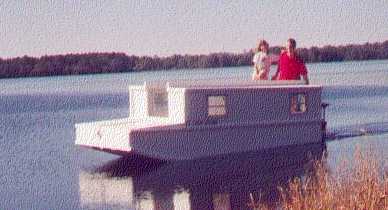
I also heard from John Applewhite, of Gainesville, Fl., who built the Harmonica shown in the photo above. He had quite a bit of shantyboat experience and also some electric experience. He used a 3 hp Minnkota and two golf cart batteries, probably about 200 pounds of gear. John said this electric is used nearly all the time with great satisfaction but he also has a small gas outboard on the transom as a backup.
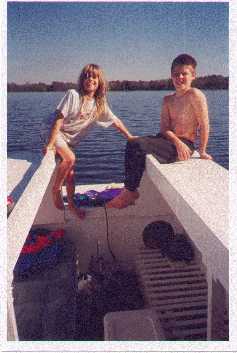
John also wrote, "...The entire family (two adults and two children) has spent the night on Steel Will. I put 1x2's between the slats in the two forward bunks and created a single bunk that is five feet wide. We have found that the thick cushions sold to cover lawn furniture very adequate mattresses for boats."
Harmonica soaks up four sheets of 3/8" plywood and six sheets of 1/4" plywood and uses simple glue and nail jigless construction. Blueprints with keyed instructions are $25.
Prototype News
Some of you may know that in addition to the one buck catalog which now contains 20 "done" boats, I offer another catalog of 20 unbuilt prototypes. The buck catalog has on its last page a list and brief description of the boats currently in the Catalog of Prototypes. That catalog also contains some articles that I wrote for Messing About In Boats and Boatbuilder magazines. The Catalog of Prototypes costs $3. The both together amount to 50 pages for $4, an offer you may have seen in Woodenboat ads. Payment must be in US funds. The banks here won't accept anything else. (I've got a little stash of foreign currency that I can admire but not spend.) I'm way too small for credit cards.
We have a Picara finished by Ken Giles, past Mayfly16 master, and into its trials. The hull was built by Vincent Lavender in Massachusetts. There have been other Picaras finished in the past but I never got a sailing report for them...
And the Vole in New York is Garth Battista's of www.breakawaybooks.com, printer of my book and Max's old outboard book and many other fine sports books. Beautiful job! Garth is using a small lug rig for sail, not the sharpie sprit sail shown on the plans, so I will continue to carry the design as a prototype boat. But he has used it extensively on his Bahamas trip towed behind his Cormorant. Sort of like having a compact car towed behind an RV.
And a Deansbox seen in Texas:
Another prototype Twister is well along:
A brave soul has started a Robbsboat. He has a builder's blog at http://tomsrobbsboat.blogspot.com. (OOPS! He found a mistake in the side bevels of bulkhead5, says 20 degrees but should be 10 degrees.) This boat has been sailed and is being tested. He has found the sail area a bit much for his area and is putting in serious reef points.
AN INDEX OF PAST ISSUES
THE WAY BACK ISSUES RETURN!
MANY THANKS TO CANADIAN READER GAETAN JETTE WHO NOT ONLY SAVED THEM FROM THE 1997 BEGINNING BUT ALSO PUT TOGETHER AN EXCELLENT INDEX PAGE TO SORT THEM OUT....
THE WAY BACK ISSUES
15mar17, Underwater Board Shape, Harmonica
1apr17, Capsize Lesson, RiverRunner
15apr17, Measuring Leeway, Mayfly16
1may17, Scarfing Lumber, Blobster
15may17, Rigging Lugsails, QT Skiff
1jun17, Rowing1, Mayfly14
15jun17, Rend Lake 2017, Mixer
1jul17, Rowing2, Viola14
15jul17, Rowing3, Vamp
1aug17, RowingSetup, Oracle
15aug17, Taped Seams, Cormorant
1sep17, OliveOly Capsize Test, OliveOly
15sep17, Plywood Butt Joints, Philsboat
1oct17, Sailing OliveOyl, Larsboat
15oct17, Water Ballast, Jonsboat
1nov17, Water Ballast Details, Piccup Pram
15nov17, Scram Pram Capsize, Harmonica
1dec17, Sail Area Math, Ladybug
15dec17, Cartopping, Sportdory
1jan18, Trailering, Normsboat
15jan18, AF3 Capsize Test, Robote
Table of Contents
